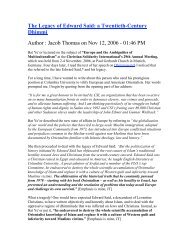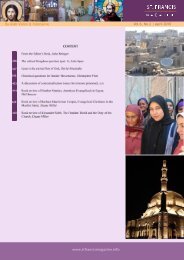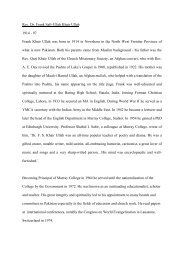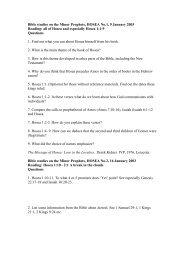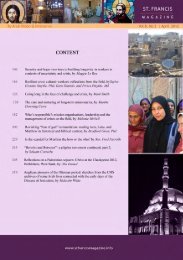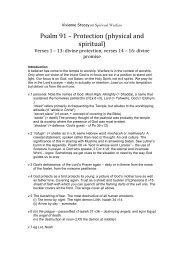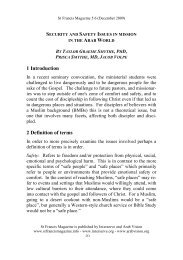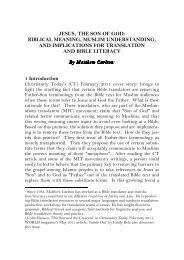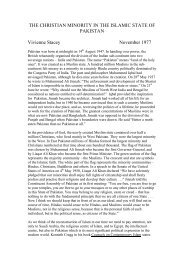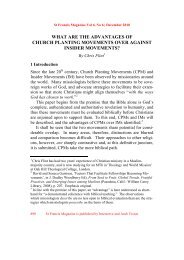download the pdf - St.Francis Magazine
download the pdf - St.Francis Magazine
download the pdf - St.Francis Magazine
Create successful ePaper yourself
Turn your PDF publications into a flip-book with our unique Google optimized e-Paper software.
<strong>St</strong> <strong>Francis</strong> <strong>Magazine</strong> Vol 8, No 4 | August 2012<br />
To varying degrees and via a variety of strategies, C5 believers<br />
in Jesus might continue to attend <strong>the</strong> mosque, might participate in<br />
its salat/prayers and <strong>the</strong> reciting of <strong>the</strong> shahada (albeit with varying<br />
strategies towards such involvement), adopt or retain patterns of<br />
diet and dress befitting <strong>the</strong>ir local Islamic culture, give alms, observe<br />
Ramadan, and may even undertake <strong>the</strong> Hajj pilgrimage to<br />
Mecca. In such diverse ways, C5 believers would identify <strong>the</strong>mselves<br />
as social and legal members of Muslim family and society,<br />
and continue to offer respect to <strong>the</strong> tenets of Islamic faith. This<br />
question of self-identity forms C5’s important but contested boundary<br />
with C4, which exists as an explicitly ‘Christian’ ‘church’, albeit<br />
making use of certain Islamic forms (see, e.g. Lewis 2009a). Whereas<br />
C6 indicates ‘private’ or ‘secret’ believers in Christ, a strategy<br />
often adopted out of fear of persecution or martyrdom resulting<br />
from a more public confession, C5 is characterised by small groups<br />
of ga<strong>the</strong>red believers typically meeting toge<strong>the</strong>r within <strong>the</strong> community<br />
of Islam. For alleged descriptions of C5 lived experience – with<br />
suitable recognition of its diverse expressions – see, e.g., Travis and<br />
Travis (2005); Bro<strong>the</strong>r Yusuf in Corwin et al. (2007); Brown (2007a);<br />
Ali and Woodberry (1999); S. Kim (2010).<br />
For definitions of insider movements, Garrison (2009) and<br />
McGavran (2009) provide wider introductions to, and overviews of,<br />
people-movement approaches to mission. For more focussed discussion<br />
with regard to specifically Islamic situations, see (e.g.) Higgins<br />
(2004: 156), and Lewis (2006, 2007, 2009b). I am aware that <strong>the</strong><br />
terms ‘C5’ and ‘insider movement’ mean different things to different<br />
people, sometimes being treated as synonymous, and sometimes<br />
being distinguished from each ano<strong>the</strong>r (Corwin 2007: 54, 55n2;<br />
Brown and Hawthorne 2009). Fur<strong>the</strong>rmore, recently at least one<br />
former proponent has rejected <strong>the</strong> ‘insider movement’ label (Higgins<br />
2010: 132nn9, 13). Here, for ease of clarity but with recognition for<br />
<strong>the</strong>se diverse opinions, I will treat <strong>the</strong> terms as broadly equivalent<br />
to each o<strong>the</strong>r. For fur<strong>the</strong>r definitional discussions, see <strong>the</strong> fourth<br />
edition of Perspectives on <strong>the</strong> World Christian Movement: A Reader<br />
(Winter and Hawthorne 2009).<br />
<strong>St</strong> <strong>Francis</strong> <strong>Magazine</strong> is a publication of Interserve and Arab Vision 454




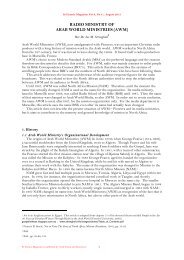
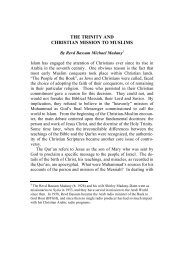
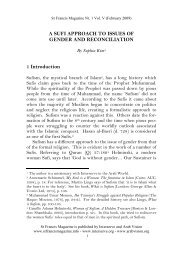
![Reflections on Surah Fatiha and the Lord's Prayer[1] - St.Francis ...](https://img.yumpu.com/49377951/1/184x260/reflections-on-surah-fatiha-and-the-lords-prayer1-stfrancis-.jpg?quality=85)
